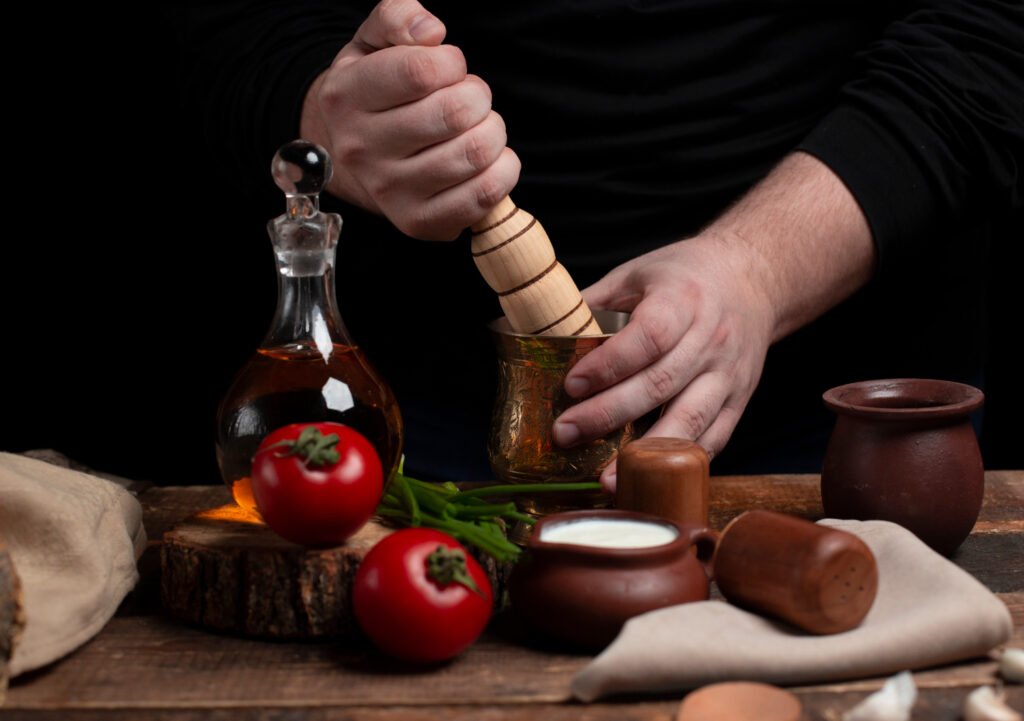Grinding Stories into Flavor
If you’ve ever walked into a kitchen where someone is crushing garlic or spices in a mortar and pestle, you know that the sound is unforgettable. It’s not just the rhythmic grinding; it’s a link to centuries of cooking traditions. The history of mortar and pestle stretches across cultures, continents, and millennia. Surprisingly, this humble tool has survived the test of time when so many others have been replaced by modern gadgets.
But why does this simple set of stone, wood, or metal still matter? And how has it shaped the way we eat today? Let’s step back in time and follow its journey through history.
Ancient Beginnings: The First Grind
Imagine living thousands of years ago, long before blenders or spice mills. People still needed to crush herbs, grains, and seeds. Archaeologists believe some of the first mortars and pestles date back over 35,000 years, often carved from stone.
-
In ancient Egypt, mortars were used not just for food but also for medicines and cosmetics.
-
In Mesopotamia, early cooks ground barley, lentils, and spices, laying the foundation for bread and stews.
-
In Mesoamerican cultures, volcanic stone mortars helped prepare cacao and maize, foods still central to the region today.
It’s fascinating that this simple act of grinding food connected daily life, ritual, and even medicine.
The Mortar and Pestle in Classical Civilizations
As civilizations grew, so did their kitchens. The Greeks and Romans didn’t just inherit the tool, they perfected its uses.
-
In ancient Greece, mortars made of marble were used for grinding herbs for both cooking and healing.
-
The Romans took it further, using mortars to create sauces, condiments, and medicines. Apicius, the famous Roman gastronome, described recipes that called for hand-ground pepper, cumin, and other spices.
What really stands out is that these societies saw the mortar and pestle not just as kitchenware, but as an essential part of health and culture.

Across Asia: Flavor Meets Tradition
Walk into a kitchen in Thailand, India, or Japan today, and chances are you’ll still see a mortar and pestle in use.
-
In India, the sil batta (a flat stone with a grinding stone) and deep mortars are still used for spice blends and chutneys. The aroma released is unmatched by any machine.
-
In Thailand, the heavy granite mortar is essential for curry pastes and papaya salad (som tam). Without it, the flavors simply don’t develop the same way.
-
In Japan, a wooden mortar called suribachi and its grooved interior are used to grind sesame seeds and miso, essential in traditional cuisine.
Here’s what this really means: while technology advanced, many Asian cuisines refused to give up the tool because the taste it produced was irreplaceable.
The Mortar and Pestle in African and Middle Eastern Traditions
If you’ve ever enjoyed hummus or spice-heavy stews, you’ve tasted the legacy of the mortar and pestle.
-
In the Middle East, mortars were key in grinding chickpeas, sesame seeds, and spices, forming the base of hummus, tahini, and za’atar.
-
Across Africa, wooden mortars are still used to pound yams, millet, and grains. The communal act of pounding food together often carries cultural meaning, beyond just cooking.
Food, here, wasn’t just fuel; it was community, ritual, and identity, all bound to the grinding stone.
The Mortar and Pestle in the Americas
From the volcanic molcajete of Mexico to the wooden mortars of South America, the Americas also kept this tool alive.
-
The Aztecs and Mayans used volcanic stone mortars for cacao drinks, sauces, and maize flour.
-
In Peru and Bolivia, traditional mortars helped prepare potatoes, grains, and herbs for Andean dishes.
Even today, salsa made in a molcajete has a smoky, rich depth that a blender can’t quite capture.
Why It Survived the Test of Time
You might wonder: with blenders, grinders, and food processors everywhere, why do people still cling to this “old-fashioned” tool?
-
Flavor Extraction – Crushing releases oils and aromas that slicing or blending just can’t.
-
Texture Control – You decide how coarse or fine the paste is.
-
Cultural Connection – Using a mortar feels like continuing a tradition, not just making food.
-
Durability – A good stone mortar can last for generations.
When you step back, it feels like this tool isn’t just practical, it’s emotional.
A Timeline of Mortar and Pestle in Cuisine
Here’s a quick overview of its journey through time and culture:
| Era / Region | Material Used | Primary Use in Cuisine | Cultural Importance |
|---|---|---|---|
| Prehistoric (35,000 BC) | Stone | Grinding seeds, grains, pigments | Daily survival, ritual use |
| Ancient Egypt | Stone, alabaster | Food, medicine, cosmetics | Sacred + practical |
| Greece & Rome | Marble, bronze | Sauces, spice blends, medicines | Culinary + medical |
| Asia (India, Japan, etc.) | Granite, wood | Spice blends, curry paste, sesame, and miso | Essential to regional cuisine |
| Middle East & Africa | Stone, wood | Hummus, tahini, pounding grains & yams | Communal & cultural |
| The Americas | Volcanic stone, wood | Salsa, cacao, and maize flour | Ritual & daily cooking |
Mortar and Pestle in Modern Kitchens
Today, chefs and home cooks alike are rediscovering the mortar and pestle. From Michelin-starred restaurants to small family kitchens, it’s making a comeback. Food bloggers and chefs often point out that pesto made by hand simply tastes more alive.
And honestly, if you’ve ever compared hand-ground spices with pre-ground ones, you’ll know exactly why.
What This Really Means for Global Cuisine
The history of the mortar and pestle isn’t just about an object; it’s about continuity. It’s proof that some methods don’t get old; they just get better with age. Every time someone pounds garlic, crushes cumin, or grinds sesame, they’re participating in a story that stretches across continents and centuries.
It reminds us that food is not only about convenience but also about culture, memory, and taste.
FAQs
Q1: What materials are best for a mortar and pestle today?
Granite is durable and versatile, while marble is smooth and elegant. Wooden mortars work best for dry grinding, while volcanic stone is ideal for salsas and sauces.
Q2: Is it worth using a mortar and pestle over a blender?
Yes, for flavor and texture. Blenders are faster, but they can heat and alter ingredients, while hand grinding preserves natural oils and aromas.
Q3: Can I use the same mortar for food and medicine, like in ancient times?
It’s not recommended. Keep separate mortars for culinary and non-culinary uses to avoid contamination.
Final Thoughts
When you think about it, the mortar and pestle is more than just a tool. It’s a living artifact, a bridge between ancient kitchens and modern ones. Its history tells us that some of the best things in cooking aren’t about speed, they’re about patience, connection, and flavor.
So next time you’re tempted to toss everything into a blender, try reaching for a mortar and pestle. You might find that what you create feels not just like food, but like a piece of history.




